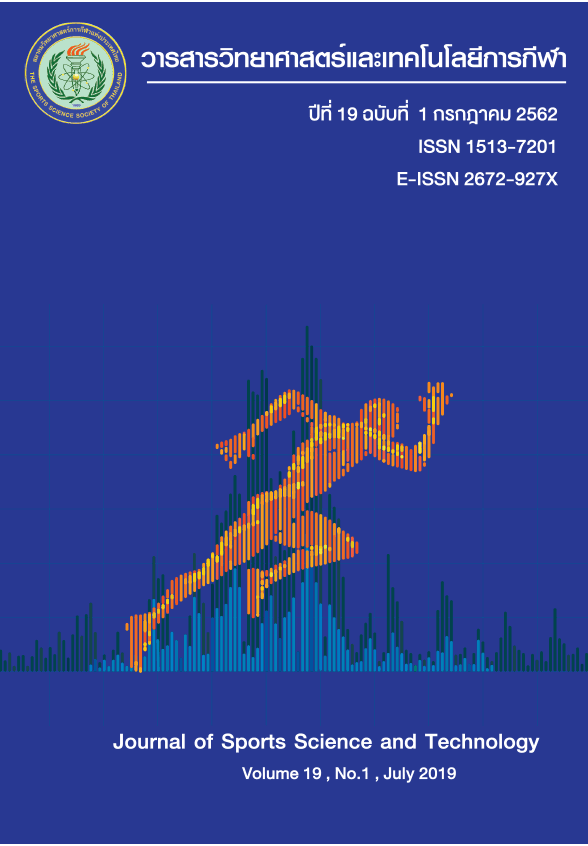MISINTERPRETATION ON THE ROLE OF GROUND REACTION FORCE AND TORQUE TO CLUBHEAD SPEED
Keywords:
Ground reaction force/ free moment/ propulsive force/ breaking force/ club head speed/ golf/ downswing phase/ balanceAbstract
Introduction: During the downswing phase, there are various styles of weight bearing on feet for creating clubhead speed in professional golfers. The style of weight bearing on feet influences the ground reaction force (GRF) and torque. However, in the contribution of the ground reaction force and the torque on clubhead speed, the understanding is not clear in some of professional golfers and sport scientists. Therefore, this review helps to clarify a basic understanding of the role of GRF and the torque which golfers usually use to control the body in the frontal and sagittal planes and to contribute clubhead speed effectively. Discussion: In a biomechanical study, the path of COP can be tracked in order to understand how body movement response relative to the GRF.During the downswing phase, ground reaction forces have roles as a propulsive force or a braking force which depends on each phase during downswing alternation. Moreover, the GRF and torque influence lower limb joint moment during the downswing and affect balance and stability control. In case of good balance and stability of the lower limbs, the kinetic chain transfers to the trunk, upper limb, and clubhead would be expected, respectively. Conclusion: During the downswing phase, the GRF and the torque influence trunk movement control. Lower limb and trunk muscles would respond according to the GRFs. Then, in good posture of the trunk and lower limbs, the clubhead speed could be enhanced. This represents an indirect role of the GRF and the torque to clubhead speed. Therefore, to enhance performance, golfers should practice and focus on trunk and lower movement controls rather than having high GRF.
(Journal of Sports Science and Technology 2019; 19(1): 25-36)
(Received: 10 August 2018, Revised: 10 May 2019, Accepted: 17 May 2019)
Keywords: Golf / Ground reaction force / Club head speed / Downswing phase
*Corresponding author: Poramet Hemarachatanon
School of Liberal Arts, Walailak University,
Nakhon Si Thammarat, THAILAND 80161
E-mail: hporamet@hotmail.com
References
Available from ; https://toddmarshfitness.com/flexibility-mobility-and-stability-in-the-golf-swing/
2. Bahamonde RE. Changes in angular momentum during the tennis serve. J Sports Sci .
2000;18(8):579-92.
3. Ball KA, Best R. Golf styles and centre of pressure patterns when using different golf clubs. J
Sports Sci. 2011;29(6):587-90.
4. Ball KA, Best RJ. Different centre of pressure patterns within the golf stroke II: Group-based
analysis. J Sports Sci. 2007;25(7):771-9.
5. Choi A, Sim T, Mun JH. Improved determination of dynamic balance using the centre of mass
and centre of pressure inclination variables in a complete golf swing cycle. J Sports Sci.
2016;34(10):906-14.
6. Choi A, Kang TG, Mun JH. Biomechanical Evaluation of Dynamic Balance Control Ability During
Golf Swing. J Med Biol Eng. 2016;36(3):430-9.
7. Hrysomallis C. Balance Ability and Athletic Performance. Sports Medicine. 2011;41(3):221-32.
8. Joyce C, Burnett A, Cochrane J, Ball K. Three-dimensional trunk kinematics in golf: between-club
differences and relationships to clubhead speed. Sports Biomech. 2013;12(2):108-20.
9. Kellie Davis. What's the Difference and Why Are They Important. 2015 September 30. Available
from ;https://www.fix.com/blog/flexibility-mobility-stability/
10. McNally MP, Yontz N, Chaudhari AM. Lower Extremity Work Is Associated with Club Head Velocity
during the Golf Swing in Experienced Golfers. Int J Sports Med. 2014;35(9):785-8.
11. McNitt-Gray JL, Munaretto J, Zaferiou A, Requejo PS, Flashner H. Regulation of reaction forces
during the golf swing. Sports Biomech. 2013;12(2):121-31.
12. Meardon SA, Derrick TR. Effect of step width manipulation on tibial stress during running. J
Biomech. 2014;47(11):2738-44.
13. Nott CR, Zajac FE, Neptune RR, Kautz SA. All joint moments significantly contribute to trunk
angular acceleration. J Biomech. 2010;43(13):2648-52.
14. Okuda I, Gribble P, Armstrong C. Trunk Rotation and Weight Transfer Patterns between Skilled
and Low Skilled Golfers. J Sci Med Sport. 2010;9(1):127-33.
15. Peterson TJ, McNitt-Gray JL. Coordination of lower extremity multi-joint control strategies during
the golf swing. J Biomech. 2018;77:26-33.
16. Queen RM, Butler RJ, Dai B, Barnes CL. Difference in Peak Weight Transfer and Timing Based
on Golf Handicap. J Strength Condit Res. 2013;27(9):2481-6.
17. Shan G, Zhang X, Li X, Hao W, Witte K. Quantification of Golfer-club Interaction and Club-type’s
Affect on Dynamic Balance during a Golf Swing. Int J Perform Anal Sport. 2011;11(3):417-26.
18. Sinclair J, Currigan G, Fewtrell DJ, Taylor PJ. Biomechanical correlates of club-head velocity
during the golf swing. Int J Perform Anal Sport. 2014;14(1):54-63.
19. Smith A, Roberts J, Wallace E, Forrester S. Professional golf coaches’ perceptions of the key
technical parameters in the golf swing. Procedia Engineering. 2012;34:224-9.





